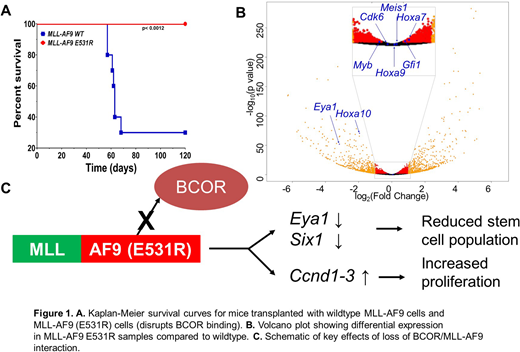Abstract
The mixed lineage leukemia (MLL) protein is a histone methyltransferase that writes the histone H3 lysine 4 trimethyl (H3K4me3) mark at the promoters of target genes such as HOXA9 and MEIS1. MLL is the target of chromosomal translocations that fuse it in frame to one of over 90 partners, leading to acute myeloid and lymphoid leukemias (AML and ALL, respectively) characterized by poor prognoses1. MLL fusions activate transcription by recruiting the AF4 family/ENL family/P-TEFb (AEP) complex and the DOT1L-AF10 family-ENL family complex (DOT1L complex or DotCom). Transcriptional activation via AF4 recruitment and transcriptional maintenance via DOT1L recruitment are required for MLL leukemias.
Despite the large number of fusion partners, members of the AEP complex account for nearly 70% of MLL rearrangements1. These fusions constitutively activate MLL targets by bypassing recruitment via ENL (MLLT1) and AF9 (MLLT3) YEATS domain binding to crotonylated or acetylated histone H3. The AF9 ANC1 homology domain (AHD), retained in MLL fusions, is intrinsically disordered, but undergoes coupled folding and binding upon interaction with its binding proteins2. The AHD recruits AF4 and DOT1L, which support transcriptional elongation, as well as the BCL6 corepressor (BCOR) and chromobox homolog 8 (CBX8), which are implicated in transcriptional repression.
CBX8 (HPC3) is a mammalian ortholog of Drosophila polycomb that binds trimethylated histone H3 lysine 9 and 27 (H3K9me3 and H3K27me3) with variable affinity. Previous reports indicate CBX8 is required for MLL-AF9 and MLL-ENL. BCOR is a transcriptional corepressor that augments BCL6-mediated repression. The BCL6 POZ domain forms a ternary complex with BCOR and SMRT, repressing targets via recruitment of PRC1.1 and HDAC3. BCOR translocations and mutations have been found in a range of cancers. Although it is broadly expressed throughout the hematopoietic system (Bloodspot), little is known about BCOR function in hematopoiesis. Recently, BCOR was shown to have a role in maintenance of human embryonic stem cell pluripotency. BCOR has also been implicated in regulation of myeloid cell proliferation and differentiation and is necessary for MLL-AF9 leukemogenesis.
While the roles of the direct MLL-AF9/AF4 and MLL-AF9/DOT1L interactions have been the subject of previous structural and functional studies2-4, the roles of the direct interactions of MLL-AF9 with CBX8 and BCOR remain relatively uncharacterized. We determined the structures of the AF9 AHD-CBX8 and AF9 AHD-BCOR complexes. Based on the structures, we developed point mutants to increase and decrease affinity of CBX8 for AF9. Increased affinity decreased colony forming ability and induced differentiation of MLL-AF9-transformed cells, while decreased affinity had no effect. An additional point mutant was developed to selectively disrupt BCOR binding to AF9. In the context of MLL-AF9, this mutant increases proliferative ability without an effect on colony formation and is unable to cause leukemia in vivo. RNAseq analysis reveals that this mutant affects a different set of genes than loss of DOT1L or AF4 binding or gain of CBX8 binding, leading to a phenotype distinct from that seen with perturbation of other AF9 interactions, functionally distinguishing proliferative capacity from in vivo leukemogenesis. In particular, substantial effects were observed on EYA1 expression, suggesting a critical role for the EYA1/SIX gene network in MLL-AF9 leukemia.
1 Meyer, C. et al. The MLL recombinome of acute leukemias in 2017. Leukemia32, 273-284, doi:10.1038/leu.2017.213 (2018).
2 Leach, B. I. et al. Leukemia fusion target AF9 is an intrinsically disordered transcriptional regulator that recruits multiple partners via coupled folding and binding. Structure21, 176-183, doi:10.1016/j.str.2012.11.011 (2013).
3 Kuntimaddi, A. et al. Degree of recruitment of DOT1L to MLL-AF9 defines level of H3K79 Di- and tri-methylation on target genes and transformation potential. Cell reports11, 808-820, doi:10.1016/j.celrep.2015.04.004 (2015).
4 Lokken, A. A. et al. Importance of a specific amino acid pairing for murine MLL leukemias driven by MLLT1/3 or AFF1/4. Leukemia research38, 1309-1315, doi:10.1016/j.leukres.2014.08.010 (2014).
No relevant conflicts of interest to declare.
Author notes
Asterisk with author names denotes non-ASH members.


This feature is available to Subscribers Only
Sign In or Create an Account Close Modal